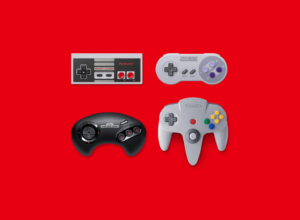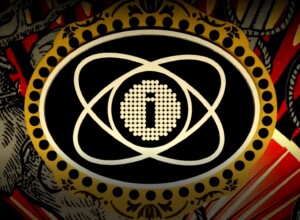How does EA Black Box’s final Need for Speed title, Need for Speed: The Run, stack up against the rest of the series, and the genre as a whole?
I grew up on Need for Speed. I played the first ten games, from Road & Track Presents: The Need for Speed up to Need for Speed: Carbon, before dipping out of the series in the latter half of the 2000s as the franchise stalled with a string of mediocrely reviewed entries.
The critical resurgence of the series under Criterion Games with their reboots of Hot Pursuit and Most Wanted deserve all praise. Despite sometimes being unfairly labeled as Burnout games with the Need for Speed moniker, the racing games under Criterion and Ghost Games (yes, even the self-titled 2015 Need for Speed) far offset the other junk releases of the series post-Carbon. Outside the games developed by Criterion and Ghost, these miscellaneous Need for Speed entries have largely been forgotten. Nevertheless, I felt compelled to try Need for Speed: The Run, EA Black Box’s final project in the franchise, given its odd narrative setup of a mad cross-country sprint.
Although hoping to discover an under-appreciated game deserving of a second shot, what I instead discovered was a missed opportunity for the series bogged down by blatant flaws and narrative shorthand. This column isn’t defending the game – as is usual for my Second Shot series – but reappraising it from a new perspective nearly six years later. By no means is The Run a good racing game, but it’s one of Need for Speed’s most offbeat efforts, and its flaws can teach us something useful in what video games value and cast aside.
Like EA Black Box’s previous game Need for Speed: Undercover, The Run attempts to expand racing game formulae with a generic crime storyline overlaid atop familiar driving gameplay. However, the developer’s endeavours to introduce features such as on-foot quick time events and encounters with armed enemies only connect the game with cheap, B-tier action/crime titles and away from the series’ racing game heritage. Unwieldy quick time events where protagonist Jack Rourke leaps across rooftops or driving sequences dodging enemy helicopters and SUV pursuers are overblown and ridiculous, suggesting that EA Black Box only aspires for unexceptional crime action undifferentiated from bargain bin junk.
The Run contains a barely sketched-in story that the developers don’t care about, but antagonists and Mafioso intrigue arbitrarily reappear during lulls in racing, with enemies begrudgingly raining down gunfire upon the player’s car mid-race. These action sequences support the game’s vague plot involving a vague debt that Jack must repay to a vague antagonist who we barely see in a vague opening cutscene devoid of context. The unfortunate story and insistence on bland crime action bogs down a decent experiment in point-to-point racing outside the more bloated efforts of Undercover or ProStreet.
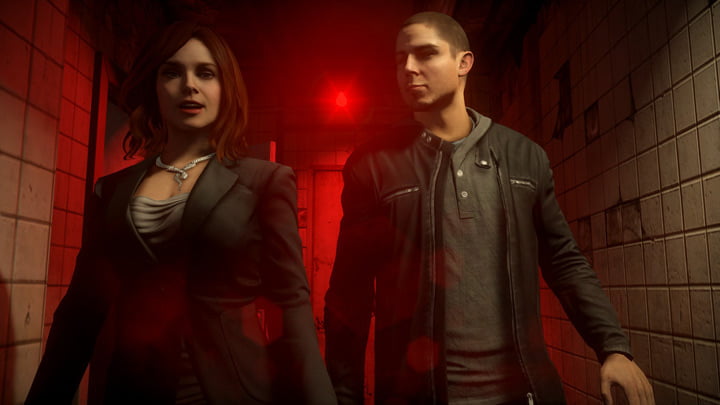
Need for Speed: The Run begins not by controlling a car, but a person. The aforementioned Jack Rourke must evade the clutches of the mob in a crime storyline lifted out of something like Gone in 60 Seconds (the Jerry Bruckheimer version, specifically). Mad Men actress Christina Hendricks serves as your earworm throughout the story, playing Jack’s confidant Sam Harper who negotiates business deals and provides coolly detached, GPS-like racing voiceover much like Jules de Jongh’s work narrating races in those of Criterion Games. In about five minutes flat, the game establishes these two main characters, the central debt conflict, the main storyline, and the eponymous race.
Jack must dash 3000 miles across the United States from San Francisco to New York City against over 200 other drivers in order to collect a neat paycheck to buy his freedom. This speediness isn’t a testament to Need for Speed: The Run’s narrative economy, but to the scant writing and flimsy setup that structures the rest of the story. While it may be severe to pick on the merits and flaws of a racing game story, comparable big-budget entertainment outside video games like the Fast and Furious movies or the Initial D anime reflect the possibility for satisfying racing narratives, and video games ought to be examined under a similar lens.
And how do racing games tell stories? My favorite series, Forza Horizon, filters the contexts for racing through a music and automotive festival. The lyrical opening cutscene of Forza Horizon 2 interweaves the mood, imagery, and textures of electronic dance music (EDM) culture to convey a sense of full sensory escapism, evoking hazy drug trips at a rave or late summer festivals. The Midnight Club series and the 2015 Need for Speed, loosely modelled after the Underground games, depict the player as an amateur driver immersed into the culture of illegal street racing, encountering miscellaneous racers alongside a curated aesthetic of hip-hop and electronic music, car customization, and nighttime urban spaces.
Need for Speed: The Run shares its story and namesake with the notorious Cannonball Baker (or Cannonball Run) cross-country race via the United States Interstate during the 1970s. However, The Run shies away from fully embracing the conceit of racing on a countrywide scale by necessitating players to pass a certain number of cars before reaching an arbitrary finish line on the Interstate in order to continue staying qualified for the run. By segmenting the race with these individual events separated by loading screens, The Run divides the full breadth of the trip into small, digestible races even though players could foreseeably pass rival cars at a later point in the game. The game is thus scripted in such a way where passing the 150th racer can only occur in Las Vegas because it’s a boss battle. If only the game were more honest with its scripted nature devoid of the pretense of the “openness” of a long drive, Need for Speed: The Run would at least benefit by not undermining expectations of a seamless road trip.

This lack of a unified experience is easily the biggest problem with Need for Speed: The Run. Since the game is split into discrete events, the game abstracts the geographical scale of a countrywide race. Reward/XP screens at the end of each event break up the forward continuity of the grander run with meaningless points and flashy animations, eliminating any sense of momentum. Moreover, by allowing players to seamlessly switch between different cars in their inventory by passing through gas stations scattered throughout the map, no forged relationship emerges with a specific car. The game also relies on ellipses that abstract the natural progression of the American landscape. In no time at all does Jack reach Yosemite from San Francisco, and the entire prairie midsection of the United States is reduced to a single sequence when in reality could comprise the bulk of a cross-country trip. The game shifts drivers towards the winding scenic sections of American roadways such as the Altamont Pass, even though the Interstate system is largely comprised of straight and long roads devoid of scenery.
These earthy, flat expanses of field and farmland are occasionally set to the game’s commendable blues-rock soundtrack from artists like The Brian Jonestown Massacre, Gary Clark Jr., and Canned Heat, evoking heartland radio stations along Route 66. However, The Run all-too frequently defers to a bland orchestral score for the duration of the game, casting aside licensed music for select sequences and not providing an ongoing playlist. The lack of an engaging soundtrack would benefit from better rapport between Jack and Sam, but the game fails to play off on the inevitable boredom of a long drive. Christina Hendricks is a talented actress, but rather than feed her lighthearted banter as an offscreen passenger, the game merely uses her as a vessel for relaying objectives: “need to make up some time, Jack.”
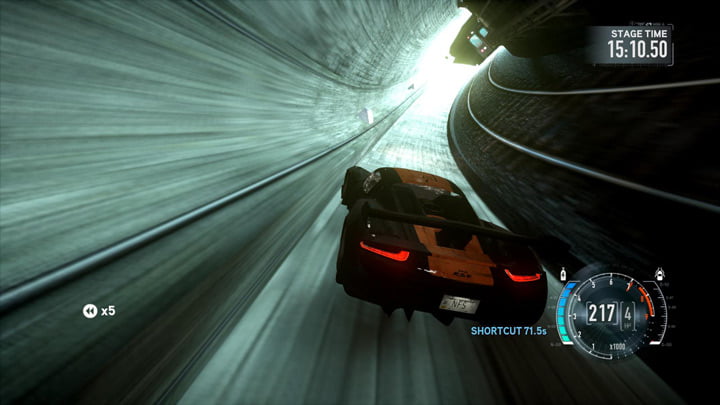
Instead, the game fills in downtime with its incomprehensible story of repaying mob debts that is neither adequately established nor fully resolved, remaining a burdensome flaw that lingers and reappears throughout the drive. The few sequences evading the mob are profoundly absurd, including one in which the protagonist plows through a burning factory littered with exploding red barrels, only to jump the car through glass windows to take out an attack helicopter midair. These Michael Bay-esque flourishes clash in tone with the racing portions of the game and can be excised completely. The main antagonist barely matters either, because it’s unclear by the epilogue of the game if Jack is fully forgiven by the mafia or if his troubles are only temporarily delayed.
Even the other racers are barely present in the story, with only two female racers receiving a cutscene (but only so the game can indulge in prepubescent male gaze as Jack ogles them from a distance). If Need for Speed: The Run weren’t so cynical in its writing and embraced goofiness and enthusiasm like the underrated 2015 Need for Speed reboot could the game actually be endearing. At the very least, the game’s runtime is whispery brief, lasting only about four hours, with the drive itself only totaling around two hours minus the numerous restarts and loading screens.

What Need for Speed: The Run ultimately feels like is a contemporary reworking of arcade cabinet racers like Cruis’n USA. Unlike track-based games like Burnout Revenge or open-world expanses like The Crew, The Run values an authored, linear experience trimmed of excess. Its tightness is commendable in a sea of overstuffed video games, recalling the original Need for Speed game’s emphasis on point-to-point racing in a variety of settings. The gorgeous Frostbite 2 engine certainly helps in establishing a vibrant world of rain-slicked roads snaking underneath waterfalls and backwoods turnpikes blanketed by yellow and orange leaves along the Savage River State Forest.
The game excels as a series of set pieces, including a police chase along the outskirts of Las Vegas in shadowy dusk and a spectacular mountainside descent during an avalanche before the exit tunnel is sealed off by snow. These high stakes moments are what make the game worth playing, but so much of The Run is saturated with the filler of humdrum racing.
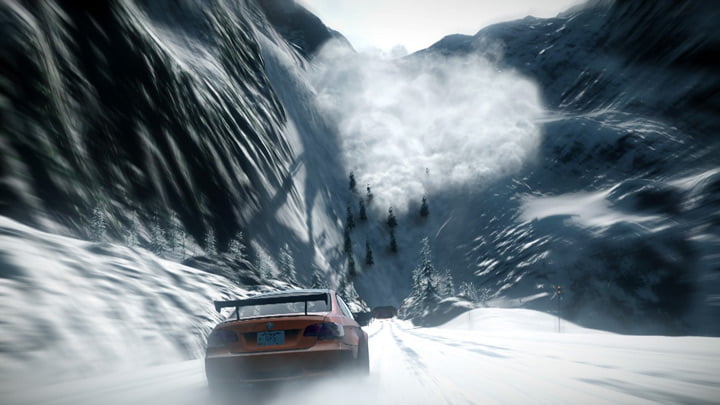
Still, a worthwhile point lingers in the mind: driving across the United States is a tedious affair and doesn’t make for thrilling action gameplay. The Game Informer review upon Need for Speed: The Run’s release argues, “San Francisco to New York is a long haul, and it’s even longer when not enough happens in between,” but perhaps the monotonous reality of a road trip could be worthwhile in the right hands.
Driving long distances may not be suitable for a Bruckheimer/Bay-style blockbuster, but it can produce thoughtful stories like Little Miss Sunshine. Perhaps a different kind of driving game is necessary; not a fast-paced racing game, but games such as Wheels of Aurelia or Kentucky Route Zero. While the blockbuster demands of the Need for Speed franchise would never yield that kind of slower, observational gameplay, they represent the artful direction driving games can take in pushing the medium forward.




